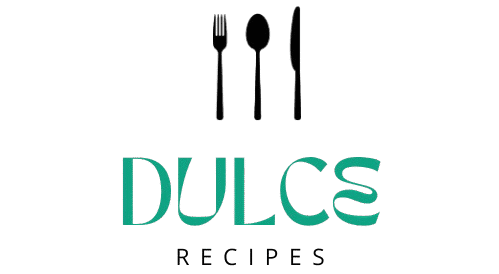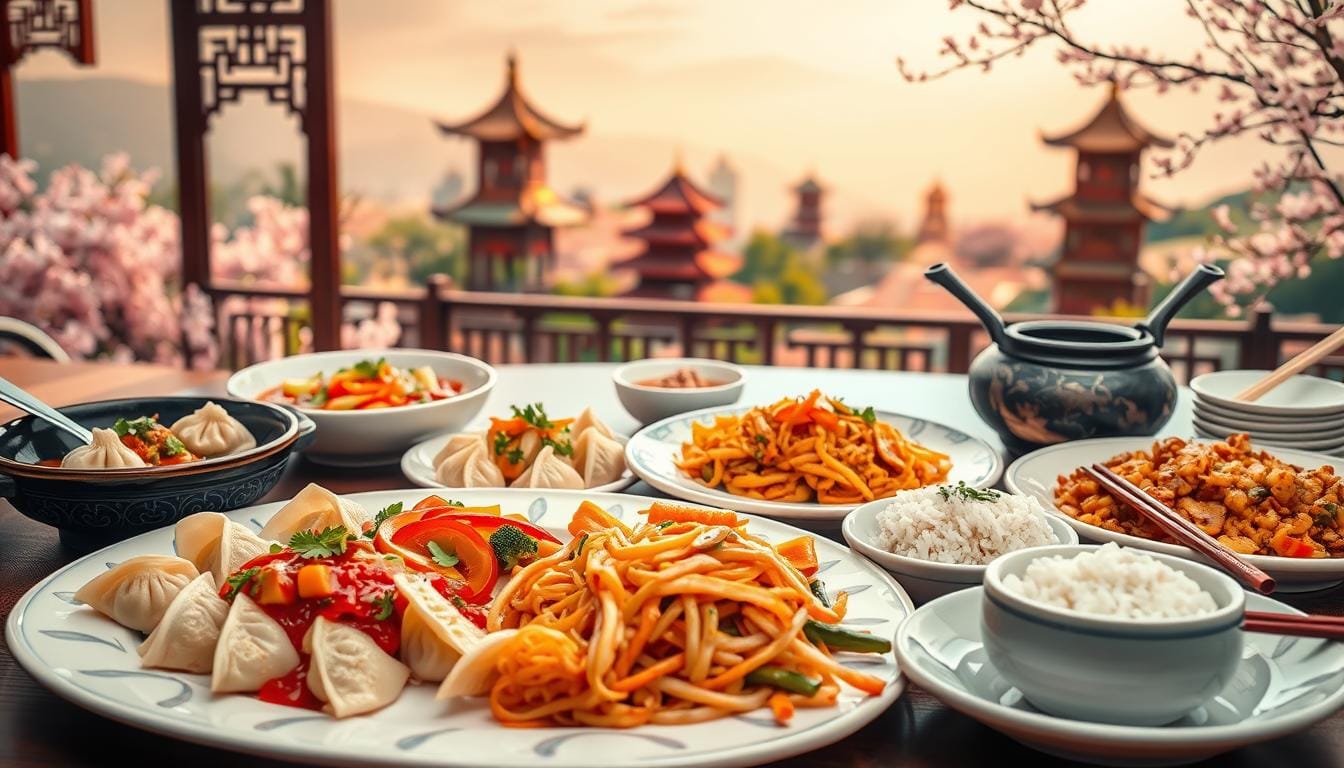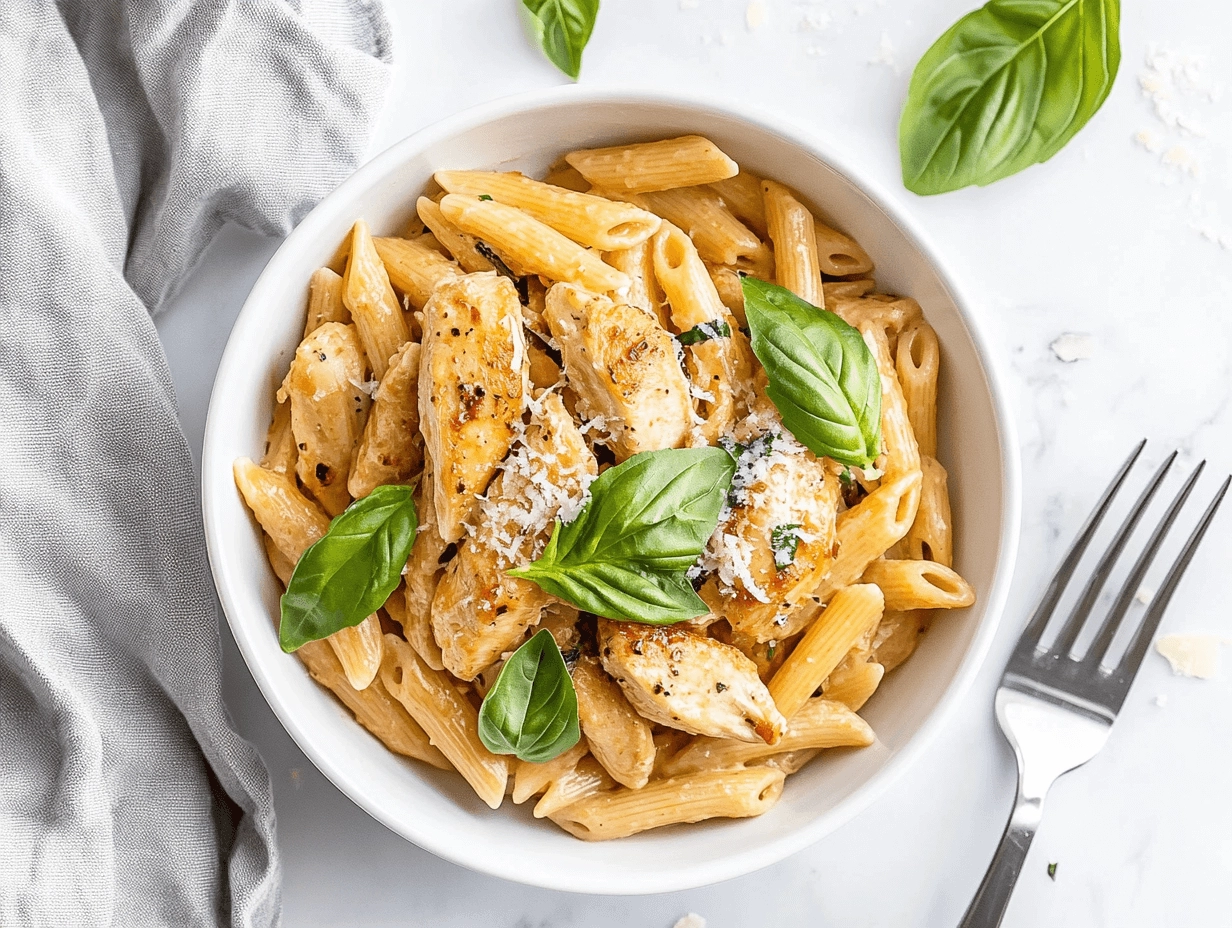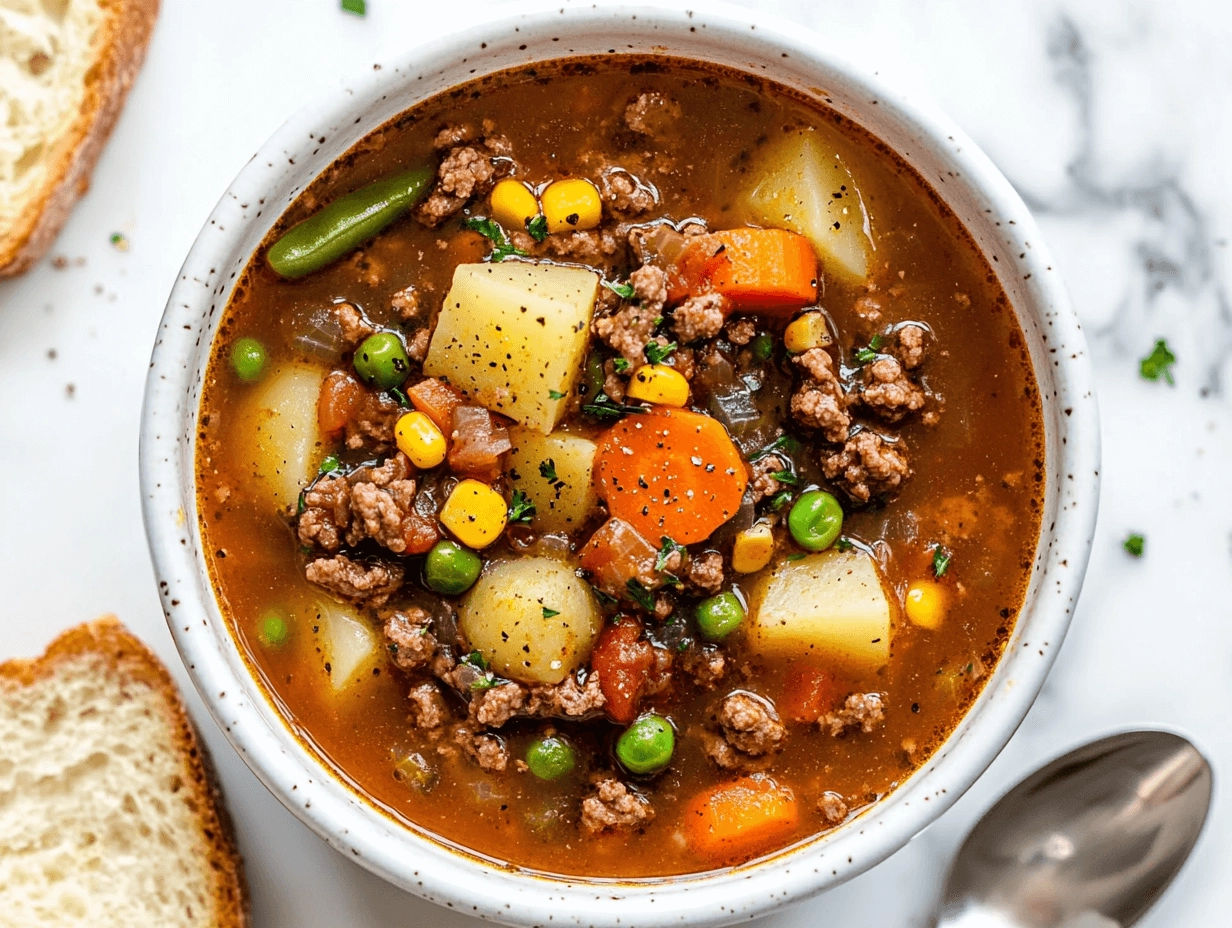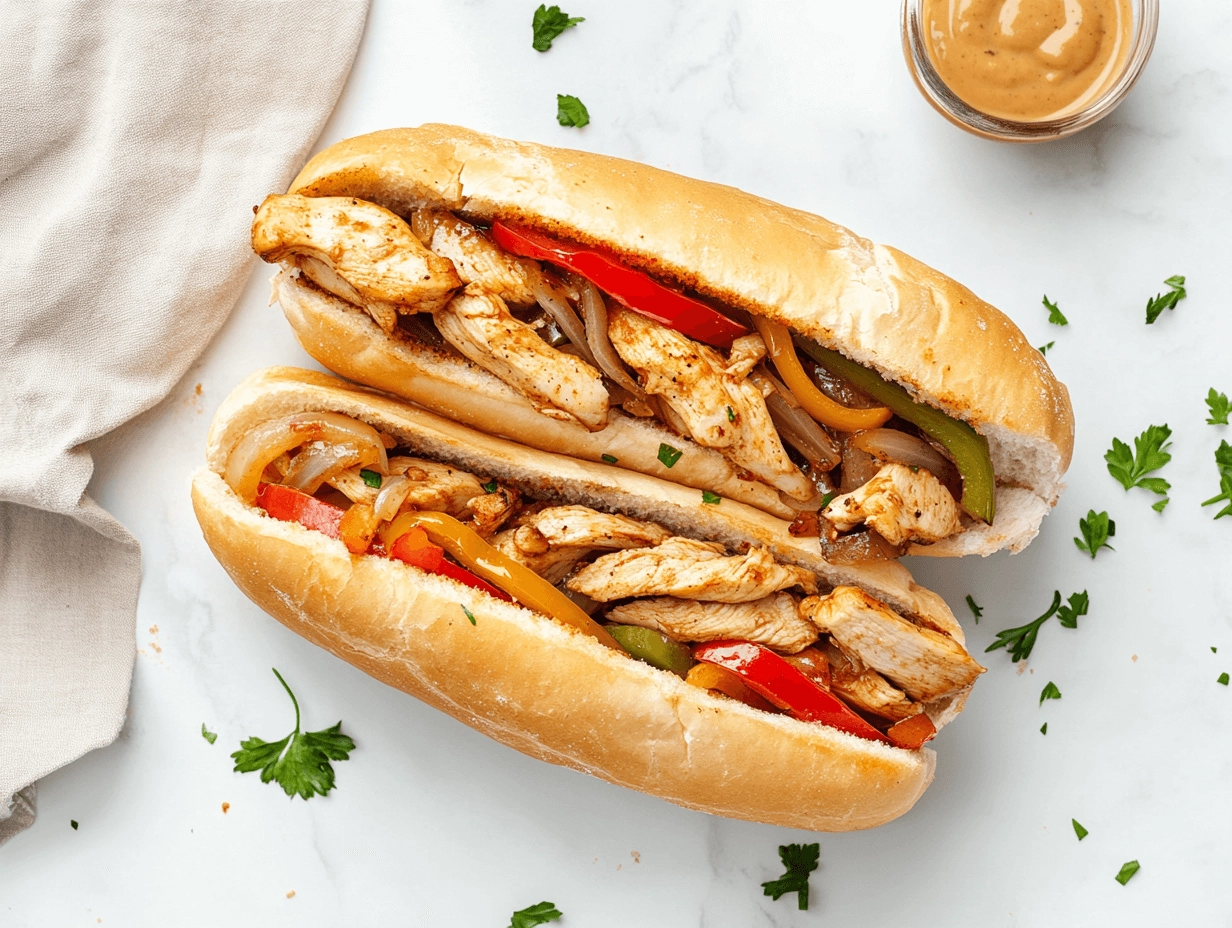Imagine turning your kitchen into a lively place where every dish takes you on a journey. Asian cuisine is a world of flavors that can change how you cook at home.
Finding real oriental dinner recipes is more than cooking a meal. It’s about diving into a world of cultural traditions. These recipes offer bold, healthy dishes that are quick to make, great for those with little time.
Asian cuisine has a wide range of dishes, from chicken to seafood. Whether you want something spicy or creamy, these recipes will make you excited to cook.
Table of Contents
Discover more delicious recipes and ideas by visiting our homepage!
Understanding the Rich Heritage of Asian Cuisine
Asian cuisine is a fascinating mix of flavors and traditions. It has grown over thousands of years. The food of Asia is as varied as its lands, shaped by history, trade, and local customs.
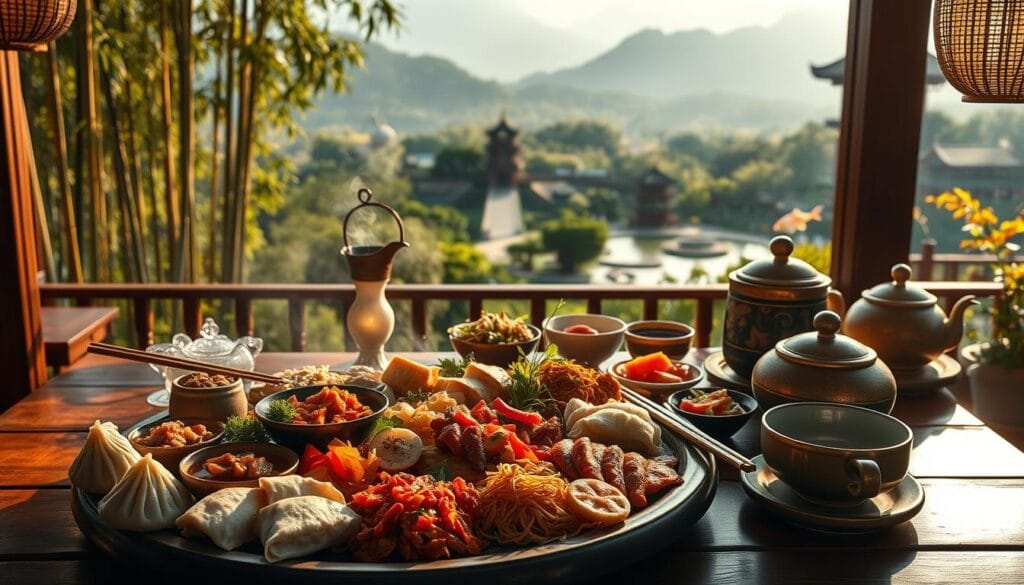
The history of Asian cooking is deep, with farming key to its flavors and methods. From India’s spicy dishes to Japan’s fine cuisine, each place has its own story in food.
Historical Influences on Modern Asian Dishes
The Silk Road changed Asian cooking by bringing in new tastes and ways to cook. Important moments include:
- Introduction of spices like saffron, pepper, and cinnamon
- Cultural exchange through trade and migration
- Development of complex spice blends and cooking techniques
Regional Cooking Techniques and Traditions
Asian foods show great variety across regions. Here are some key traits:
| Region | Culinary Characteristics |
|---|---|
| China | 8 distinct regional styles, complex flavor profiles |
| Japan | Emphasis on seasonality and fresh ingredients |
| India | Over 200 spice varieties in cooking |
| Southeast Asia | Frequent use of lemongrass and coconut milk |
Essential Asian Cooking Methods
Knowing traditional cooking ways helps us value Asian cuisine. Popular methods include:
- Stir-frying for quick, high-heat cooking
- Steaming to preserve ingredient nutrients
- Braising for tender, flavor-rich dishes
By learning these techniques and traditions, you’ll appreciate the amazing world of Asian cooking and its rich culture.
Essential Ingredients for Oriental Dinner Recipes

Exploring eastern culinary traditions means learning about key ingredients. These ingredients turn simple meals into unforgettable dishes. Start your journey by mastering the basics that add depth and authenticity to every meal.
Spice blends are the heart of Asian cuisine, adding layers of flavor. These magical mixes turn simple ingredients into memorable meals. Let’s look at the essential pantry staples that will change your cooking:
- Fresh Aromatics: Ginger, garlic, and lemongrass form the flavor foundation
- Sauces: Soy sauce, fish sauce, and oyster sauce add umami complexity
- Proteins: Tofu, tempeh, and various lean meats provide nutritional balance
- Vegetables: Bok choy, shiitake mushrooms, and water chestnuts bring texture
Your spice collection should include blends like Chinese five-spice powder, Thai curry pastes, and Korean gochugaru. These unique mixes turn ordinary ingredients into authentic oriental dishes. They will impress your family and friends.
Quick tip: A well-stocked Asian pantry includes sesame oil, rice vinegar, and dried spices. These can be combined to make restaurant-quality meals in under 30 minutes.
Classic Thai-Style Pad Thai with Shrimp
Explore the world of Thai cuisine with an authentic Pad Thai dish. It’s a mix of sweet, sour, and savory flavors. This dish brings the streets of Bangkok to your kitchen.
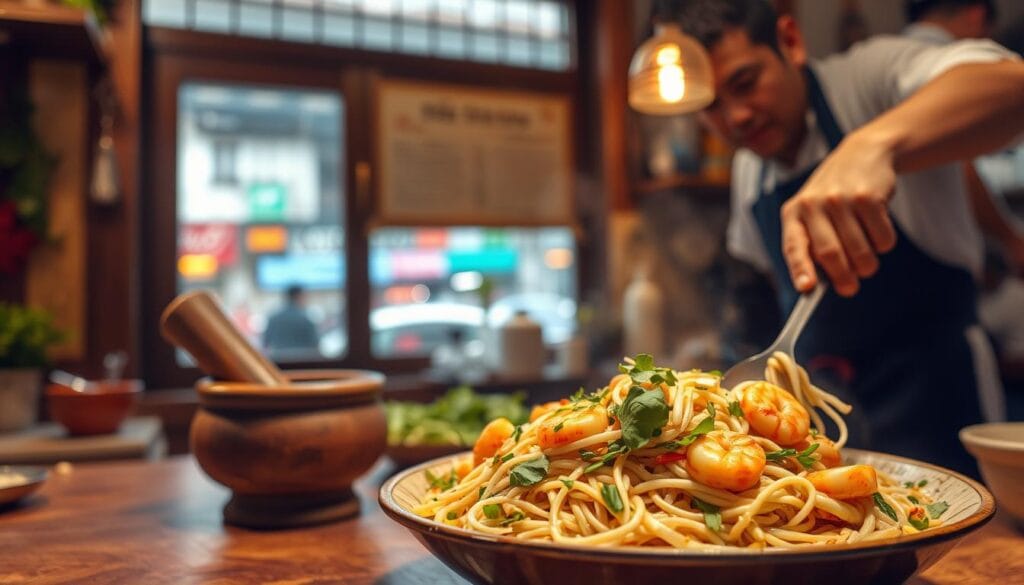
Making Pad Thai is all about detail and traditional cooking. Let’s look at what makes it so loved.
Preparing the Perfect Rice Noodles
Rice noodles are key in Pad Thai. Here’s how to get them right:
- Soak dry rice noodles in room temperature water for exactly 1 hour
- Drain noodles completely before cooking
- Use 4 oz (112 g) of dry rice noodles for a standard serving
- Ensure noodles are at room temperature before stir-frying
Mastering the Signature Pad Thai Sauce
The sauce is what makes Pad Thai special. It should have:
- 1 Tbsp soy sauce
- 1 ½ Tbsp fermented soybean paste
- 2 ½ – 3 Tbsp tamarind paste
- Palm sugar for sweetness
Garnishing Tips for Authentic Presentation
Make your Pad Thai stand out with these garnishes:
- Sprinkle ¼ cup chopped roasted peanuts
- Add fresh bean sprouts (1 cup)
- Garnish with lime wedges
- Optionally add 2 eggs for extra protein
Pro tip: Stir-fry quickly over high heat. This adds the smoky “wok hei” flavor. Your homemade Pad Thai will be just as good as any restaurant’s!
Savory Chinese Beef and Broccoli Stir-Fry
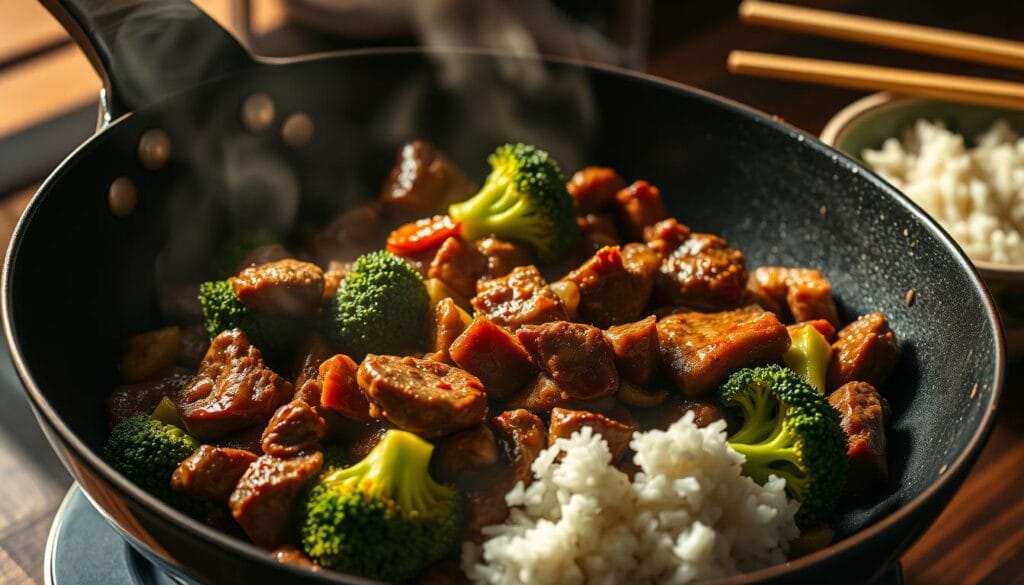
Discover a classic Chinese beef and broccoli stir-fry, one of the easiest oriental dinner recipes. It turns a takeout favorite into a home-cooked dish that’s both tasty and simple to make.
This stir-fry is a great choice for a quick and nutritious meal. It combines tender beef with crisp broccoli in a delicious sauce. It’s as good as any restaurant version.
Ingredients and Nutritional Breakdown
- Protein Powerhouse: 1-1.5 pounds of flank or chuck steak
- 1.5 pounds of fresh broccoli florets
- Essential sauce ingredients:
- ⅓ cup chicken broth
- ¼ cup low-sodium soy sauce
- 3 tablespoons oyster sauce
Nutritional highlights per serving include:
- 337 calories
- 35g protein
- 14g fat
- 19g carbohydrates
Cooking Technique Secrets
The secret to a great beef and broccoli stir-fry is velveting the beef and cooking at high heat. Velveting involves marinating the beef with cornstarch and baking soda for 20 minutes. This makes it tender.
When stir-frying, cook the beef for 1-2 minutes per side. Cook the broccoli for 2-3 minutes. This keeps it vibrant and crisp.
Pro tip: Freeze your beef for 10-30 minutes before slicing. This helps get those perfect thin strips that cook quickly and stay tender.
Storage and Meal Prep
- Refrigerate leftovers: Up to 3 days
- Freeze for later: Up to 3 months
- Total preparation time: Approximately 30 minutes
This classic oriental dinner recipe brings restaurant-quality flavor to your kitchen. It shows that delicious Asian cuisine is easy to make at home!
Creamy Indian Butter Chicken
Discover the magic of Indian cuisine with this mouthwatering Butter Chicken recipe. It brings restaurant-quality flavors right to your kitchen. This iconic dish represents the rich culinary traditions of oriental dinner recipes, blending complex spices and tender chicken into a truly memorable meal.
The secret to authentic Butter Chicken lies in its carefully selected ingredients. This dish showcases an impressive array of spices and flavors. These transform simple chicken into a culinary masterpiece.
Marinating Techniques for Tender Chicken
Preparing the perfect Butter Chicken starts with a robust marinade. Here’s how to ensure your chicken remains incredibly tender:
- Use 1.5 pounds of chicken breast
- Mix 1/2 cup Greek yogurt for tenderizing
- Add 1 teaspoon lemon juice
- Incorporate key spices:
- 1 teaspoon grated ginger
- 1 teaspoon ground cumin
- 1/2 teaspoon ground turmeric
Creating the Perfect Curry Base
The heart of Butter Chicken is its luxurious sauce. Your curry base will include:
- 2 tablespoons tomato paste
- 1/2 cup heavy cream
- 2 teaspoons garam masala
- 1 tablespoon butter for sautéing
Serving Suggestions and Accompaniments
Elevate your Butter Chicken experience by serving it with:
- Basmati rice
- Warm naan bread
- Fresh cilantro garnish
Pro tip: Let the chicken marinate for at least 3 hours to maximize flavor infusion. Your total cooking time will be approximately 35 minutes. This dish serves 6-8 people, with each serving packed with 38g of protein.
Vietnamese Banh Mi Sandwich with Pork
Learn to make a healthy dinner at home with the Vietnamese Banh Mi sandwich. It’s a mix of French and Vietnamese flavors. This meal is both healthy and full of taste.
Making a real Banh Mi needs good ingredients and care. You can make it in just 20 minutes. It’s great for a quick, tasty dinner.
Key Ingredients for Your Banh Mi
- French baguette
- Grilled pork or tofu
- Pickled vegetables
- Fresh herbs
- Savory condiments
To make a healthy dinner at home, focus on these key parts:
- Protein Selection: Pick lean pork or tofu for a lighter option
- Fresh Vegetables: Pickle daikon and carrots for authentic crunch
- Balanced Condiments: Use minimal mayonnaise and pate
Each sandwich usually has:
- 2 tablespoons pickled daikon and carrots
- 2 slices of ham
- 2 tablespoons cucumber
- 1 tablespoon cilantro
- Optional jalapeño for spice
The Banh Mi is great for a healthy dinner at home. It has protein, veggies, and lots of flavor. By choosing your ingredients and portion sizes, you can make a nutritious meal that feels like a trip to Vietnam.
Japanese Chicken Katsu with Tonkatsu Sauce
Explore international flavors with this Japanese favorite. Chicken Katsu turns a simple chicken cutlet into a crispy, golden delight. It will take your taste buds to Tokyo.
This dish combines crispy breading with tender chicken. It’s a mouth-watering experience that’s both comforting and exciting. Let’s dive into making the perfect Chicken Katsu.
Breading and Frying Techniques
Making perfect Chicken Katsu needs precision and care. Here’s how to get the ultimate crispy coating:
- Select boneless, skinless chicken thighs or breasts (1 pound)
- Prepare a wet batter with 2 large eggs and 1 tablespoon of whole milk
- Create a dry coating using 1/2 cup all-purpose flour
- Use 2 cups of panko breadcrumbs for an extra crispy exterior
Cooking Method
The secret to great Chicken Katsu is in the frying:
- Fry each piece for 3-4 minutes per side
- Aim for a golden-brown color
- Maintain oil temperature around 340-355°F
| Nutritional Information | Per Serving |
|---|---|
| Calories | 523 kcal |
| Protein | 27 g |
| Carbohydrates | 15 g |
| Fat | 37 g |
Side Dish Pairings
Complete your Chicken Katsu with traditional sides:
- Shredded cabbage slaw (4 cups green cabbage)
- Steamed white rice
- Miso soup
- Tonkatsu sauce (made with ketchup, Worcestershire sauce, and brown sugar)
Pro tip: For maximum crispiness, try the double-frying technique and serve immediately. Your homemade Chicken Katsu will rival any restaurant’s version!
Kitchen Tools and Equipment for Oriental Cooking
Preparing authentic oriental cuisine needs special kitchen tools. These tools make cooking more enjoyable. Having the right equipment is key to mastering exotic ingredients and cultural delicacies.
Some essential tools for oriental cooking are:
- Carbon steel wok for even heat distribution
- Bamboo steamers for delicate cooking techniques
- High-quality chef’s knife for precise cutting
- Rice cooker with multiple settings
- Mortar and pestle for fresh spice pastes
When picking your tools, look for ones that do more than one thing. A 14-inch carbon steel wok is great for stir-frying. It can also boil, deep fry, and steam dishes.
| Tool | Price Range | Key Feature |
|---|---|---|
| Carbon Steel Wok | $30-$80 | Fast, even heating |
| Rice Cooker | $53-$200 | Multiple cooking settings |
| Bamboo Steamer | $38-$60 | Authentic steaming method |
Pro tip: Pick tools that are durability and versatility. A good set of kitchen equipment can turn your oriental cooking into something amazing. It lets you make meals as good as those in restaurants, right in your own kitchen.
Tips for Meal Planning and Preparation
Exploring eastern culinary traditions means smart meal planning and preparation. Whether you’re busy or passionate about cooking, learning to prepare oriental cuisine can change your kitchen. It makes cooking more fun and efficient.
Streamlining your meal prep can make cooking faster. Studies show that good meal planning can:
- Reduce food waste by up to 25%
- Save families an average of $1,500 annually
- Improve meal satisfaction by 40%
Shopping Guide for Asian Ingredients
Having the right spice blends and ingredients is key for real oriental dishes. Here are some shopping tips:
| Ingredient Category | Recommended Items | Storage Tips |
|---|---|---|
| Pantry Staples | Soy sauce, rice vinegar, sesame oil | Cool, dark place |
| Spice Blends | Five-spice powder, curry powder | Airtight containers |
| Fresh Produce | Ginger, garlic, green onions | Refrigerate |
Make-Ahead Strategies
Here are ways to make cooking more efficient:
- Prep ingredients ahead of time
- Create mise en place for quick cooking
- Batch cook sauces and marinades
- Freeze portioned proteins
By using these tips, you’ll make your cooking better. You’ll save time and make delicious, authentic meals easily.
Health Benefits of Oriental Dinner Recipes
Asian cuisine is more than tasty flavors. It’s also packed with nutrients that can change how you eat. Oriental dishes are made with fresh ingredients and smart cooking methods.
These recipes have amazing health benefits:
- Low in calories, with most dishes averaging around 336 calories per serving
- High protein content, often reaching up to 35g per serving
- Rich in essential vitamins and minerals
- Abundant in vegetables and lean proteins
Ingredients like ginger, garlic, and turmeric are full of health benefits. They have anti-inflammatory properties and antioxidants that boost wellness. Cooking methods like steaming and stir-frying keep nutrients in while cutting down on fats.
Your meals can be very nutritious. For example, a typical oriental dish might give you:
- Vitamin A: 26% of Daily Value
- Vitamin C: 84% of Daily Value
- Calcium: 17% of Daily Value
- Protein: 70% of Daily Value
By choosing oriental dinner recipes, you’re not just eating well. You’re also taking care of your health with nutrient-rich, balanced meals.
Storage and Leftover Management
Learning to store and reuse your oriental dinner recipes can change your cooking at home. When you make easy oriental dinner recipes, managing leftovers well is key. It keeps flavors fresh and cuts down on waste.
Knowing how to store food right makes your meals last longer. Here are some tips for handling leftovers:
- Refrigerate cooked dishes within 2 hours of making them
- Use airtight containers to keep food fresh
- Label containers with the date you made them
- Keep different ingredients apart when you can
For the best storage, follow these tips for your oriental dinner recipes:
- Rice-based dishes: Store in the fridge for 3-5 days
- Stir-fry meals: Keep in sealed containers for up to 4 days
- Saucy dishes: Freeze for up to 3 months
Turning leftovers into new meals can make your food exciting again. Try making fried rice from yesterday’s stir-fry or using leftover curry sauce as a marinade. This way, you create new dishes and save food from going to waste.
Also, 70% of home cooks enjoy leftovers more when they’re presented in a creative way. Try new things with your oriental dinner recipes and find amazing new flavors!
Conclusion
Creating tasty oriental dinners at home is easy and fun. Ingredients like soy sauce, sesame oil, and fresh garlic make your kitchen lively. These five recipes show the wide range of Asian cuisine, from Thai pad thai to Japanese chicken katsu.
Making a healthy oriental dinner at home is simple. Recipes take just 10 to 40 minutes to prepare. You can change proteins or ingredients to fit your diet and taste.
Your cooking journey is just starting. Every new recipe you try adds to your skills and knowledge of Asian food. You’ll become more confident in making delicious meals for your loved ones.
Cooking is a journey of discovery. Each dish shares a story of cultural heritage, bringing Asia’s flavors to your table. Enjoy the process, try new things, and relish the tasty outcomes of your efforts.
FAQ
What are some easy oriental dinner recipes to make at home?
Easy oriental dinner recipes include Pad Thai and Beef and Broccoli Stir-Fry. Also, try Butter Chicken, Banh Mi Sandwich, and Chicken Katsu. These dishes are great for beginners and can be made with simple ingredients and techniques.
What ingredients are commonly used in oriental dinner recipes?
Key ingredients are soy sauce, fish sauce, ginger, and garlic. Rice noodles, rice vinegar, and sesame oil are also common. Spices like five-spice powder and curry pastes add flavor. Fresh veggies like bok choy and carrots are used a lot too.
How can I make a healthy oriental dinner at home?
Use stir-frying or steaming to cook. Choose lean proteins like chicken or tofu. Add lots of veggies and control oil use. Pick whole grains like brown rice and use low-sodium sauces. Ginger and garlic are great for health.
Do I need special equipment to cook oriental recipes?
A wok is best, but a large skillet works too. You’ll need a good knife, cutting board, and basic utensils. A rice cooker, bamboo steamer, and mortar and pestle are helpful for authentic flavors.
Where can I find authentic oriental ingredients?
Asian grocery stores and international markets have authentic ingredients. Supermarkets with international aisles also have what you need. Online retailers specialize in Asian cooking ingredients, making it easy to find what you need.
Are oriental dinner recipes typically spicy?
Spice levels vary across Asian cuisines. Some, like Sichuan, are very spicy. Others, like Japanese, are milder. You can adjust spice to your liking by changing chili pepper or sauce amounts.
Can I make oriental recipes vegetarian or vegan?
Yes! Many oriental dishes can be made vegetarian or vegan. Use tofu, tempeh, or seitan instead of meat. Vegetable broths are better than meat stocks. Dishes like Pad Thai and stir-fries are perfect with plant-based proteins.
